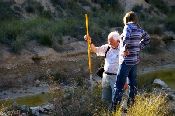|
The area and people
On this site the majority of the farmers are small farmers.
Added value of DESIRE for stakeholders
The local actors hope that this project will influence the decision makers to finance the implementation of the solutions. The INIA felt a very strong expectation of the local actors.
Study site stakeholder workshops
One day with the local actors; small farmers, big owners, representatives of 4 institutes of research (INIA, IDAP, IRD), representatives of companies and a technician of the municipality. Then two days with the external actors. The INIA was very satisfied with the participation.
Limitations for spontaneous implementation of soil and water conservation practices
The solutions are too expensive for these poor populations and absence of a public policy.
Stakeholder groups
- A fundamental and key user institution of the information generated by the project would be the Institute of Agricultural Development (INDAP, http://www.indap.gob.cl). INDAP has for mission to attend technically and to lend credit to the small farmers of Chile. In particular in the Mediterranean region INDAP develop programs for recovery degraded soils, fomenting tools for soil conservation like the construction of simple structures for erosion control at farm level, cover crops and sown pastures, and the plantation of trees with agro-forestry purposes.
- The Centre of Education and Technology (CET, http://www.corporacioncet.cl) has the mission of help small farmers to increase their life quality improving their technology, agriculture productivity and sustainability of natural resources. The CET has an active role on the articulation of rural organizations with county authorities, research centers and state institutions, in order to have influence on the design of new polices related with rural life.
- A number of NGOs are available in the secano interior working with small farmers, like Agraria, Grupo de Investigaciones Agrarias (GIA, http://www.gia.cl) among others.
- The large majority of the land in the “secano interior” is private, therefore farmers and forest companies will the final users. An active divulgation program will be necessary for the diffusion of new technologies to small, medium and large farmers, as well as forest managements.
Sustainability goals
The areas of rainfed agriculture in Mediterranean Central Chile have at least 2 main attributes, which should be preserved and enhanced. First is the livelihood for a significant number of farmers (c. 300.000), who use and generate their incomes from agriculture activities, and contain a valuable cultural and social heritage that the country can not lose. Secondly, being semi-natural areas, where the anthropogenic impact on the environment have been not as overwhelming or devastating as in other areas of more intensive agriculture, these zones have great interest in terms of biodiversity and semi natural landscape.Taking into account both aspects the sustainability goals are to allow rural population to improve their living conditions and to conserve natural and cultural patrimonies.
| Goal 1 |
Enhancement of the productive potential of the dryland agroecosystems |
| Goal 2 |
Rehabilitation and restoration of degraded soils |
| Goal 3 |
To decrease and control soil degradation (erosion and fertility depletion) |
| Goal 4 |
To enhance water storage capacity of the soils and watershed |
| Goal 5 |
Maintenance of balance between ecological and productive value of the agro-ecosystems |
| Goal 6 |
Design, implementation and introduction of technological innovations in the traditional farming systems allowing rural population to improve profitability, productivity and sustainability of agriculture, preserving the environment and cultural and natural patrimony of this vast area of Central Chile |
Source: Stakeholder workshop (goals 1-4), Ministry of Agriculture policy document (goals 5 and 6)
|



